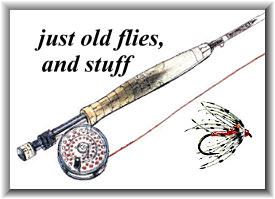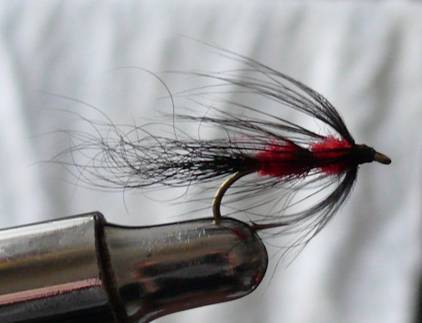
Welcome to 'just old flies,' a section of methods and flies that used-to-be. These flies were tied with the only materials available. Long before the advent of 'modern' tying materials, they were created and improved upon at a far slower pace than today's modern counterparts; limited by materials available and the tiers imagination.
Once long gone, there existed a 'fraternity' of anglers who felt an obligation to use only the 'standard' patterns of the day. We hope to bring a bit of nostalgia to these pages and to you. And sometimes what you find here will not always be about fishing. Perhaps you will enjoy them. Perhaps you will fish the flies. Perhaps?
FLETCHER’S FUZZY WUZZY

Fred Fletcher opened up his fishing lodge in the 1930s. His lodge was situated on the Mangamutu Stream near where it joined the Waitahanui River before it flowed into Lake Taupo. Despite the depression, the lodge was a success and Fred became a well known local celebrity. A book on his life, entitled “Mr. 100 Percent” was written by a friend of his, Keith Draper.
Keith, incidentally, has put together a few books documenting the fly patterns of New Zealand, and the stories behind many of them. Fred Fletcher designed the “Fuzzy Wuzzy” to imitate the koura, or fresh water crayfish. His original tie had the hackle palmered the length of the body with a long tail of squirrel tail hair. Had he used marabou, then Fred Fletcher would have invented the woolly bugger! However, the pattern eventually changed and became tied with two hackles, one tied in mid body.
Fuzzy Wuzzies are defined by the black tail and two black hackles, with different body colours indicated in the name; i.e. Red Fuzzy Wuzzy, Green Fuzzy Wuzzy, and so forth. Tied in large sizes, say size 4 using chenille for the body material, and fished at night these are very good still water flies. In smaller sizes, 10, 12 or even 14s, these are good river flies.
In still waters, the Fuzzy Wuzzy is generally fished near the bottom, in short pulls, which cause the hackles to pulse in and out like the legs of the crayfish to maintain Fred’s original explanation. In moving waters, they are probably best fished in a down and across type presentation as an attractor wet fly pattern.
This “bi-hackle” construction style leads to a number of variations, such as the Red Setter (orange body, and fox squirrel tail, and ginger hackles originally produced by Geoff Sanderson of Turangi) which is probably the most famous pattern of this style. Note that if you make the front body segment green, then the Red Setter becomes an Irish Setter.
Another variation on this construction style is the Dapple Dogs (grey squirrel tails, grizzle hackles, and florescent orange or florescent green body, also by Geoff Sanderson). Interestingly, I’ve seen a white tailed, white hackled, fluro pink bodied version listed in an older American Steelhead magazine, a pattern that is called a Disco Doll here in New Zealand. Anyway, all of these “bi-hackle” flies are, of course, simply colour variations of the original Fletcher’s Fuzzy Wuzzy. It’s a simple, yet effective tie. And, there is lots of room for experimentation, especially if you start to tie in two contrasting feathers for each of the hackles, as with the brown and grizzle hackles used for the collar of an Adams. Also, with the hackle stem buried under the body, I think this construction method may help protect the hackle feather from being bitten in half, which I find occurs a bit frequently with woolly buggers. I’m not sure of this though. I am sure that these did, and still do, catch a lot of fish.
Jeff Hamm, Auckland, New Zealand
[ HOME ]
[ Search ] [ Contact FAOL ] [ Media Kit ]